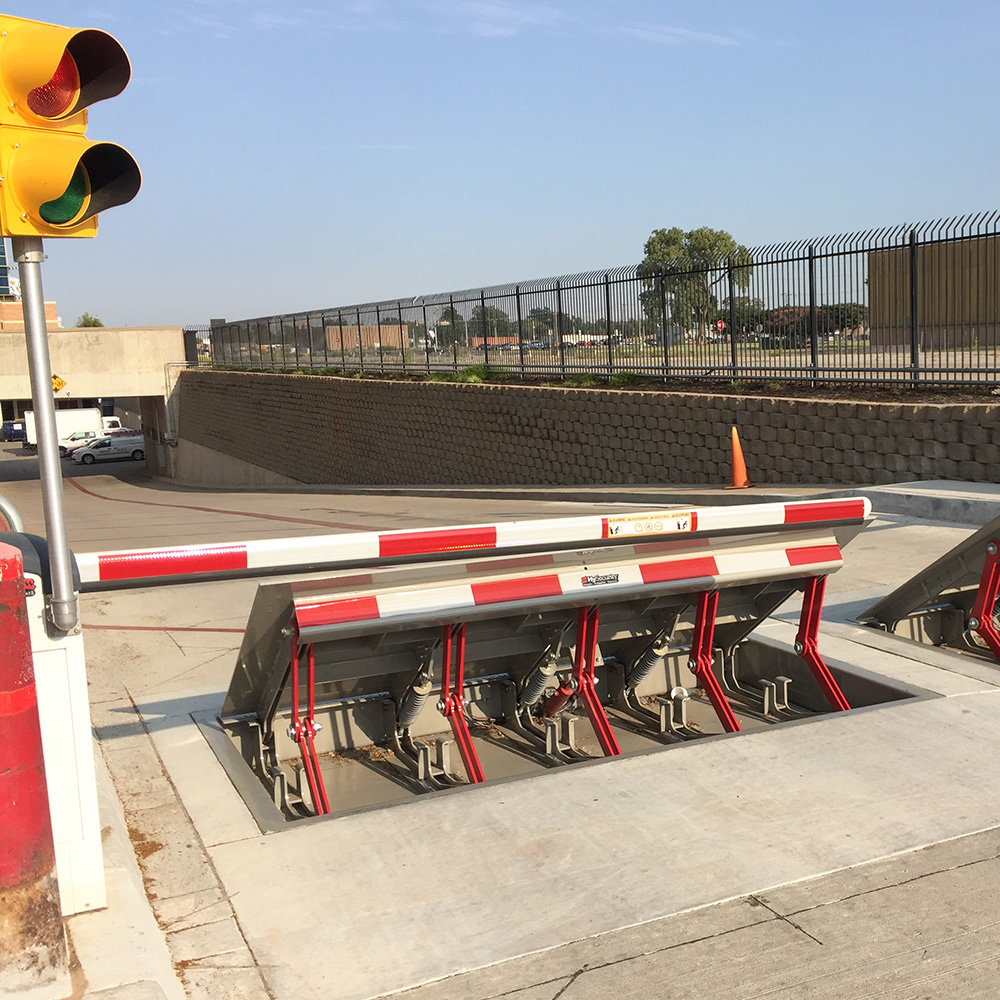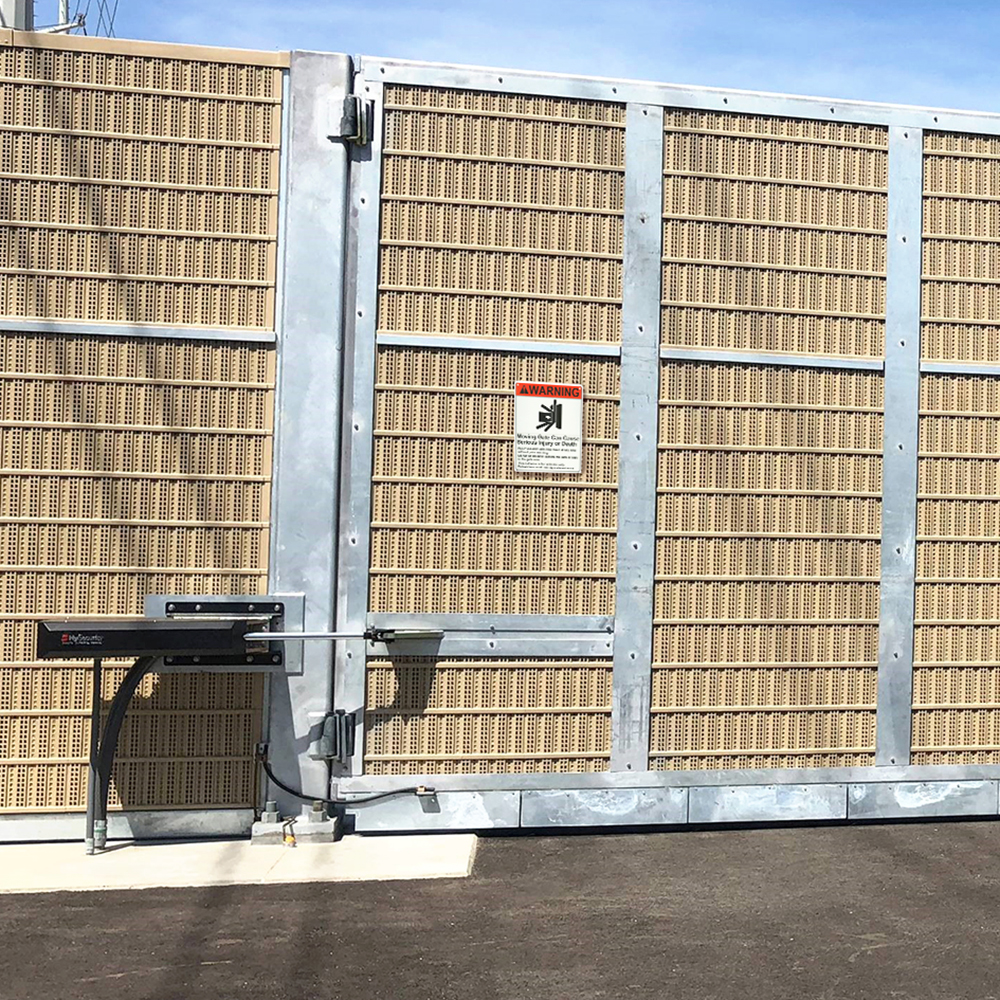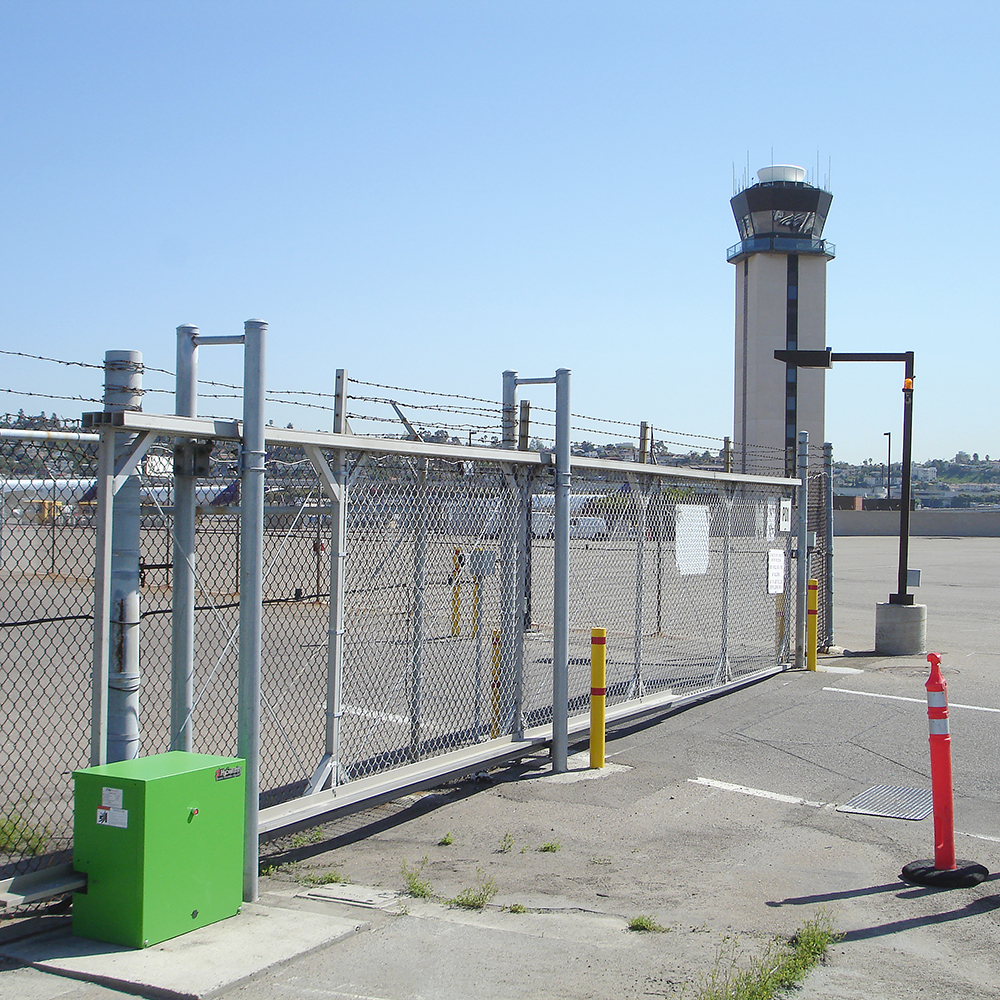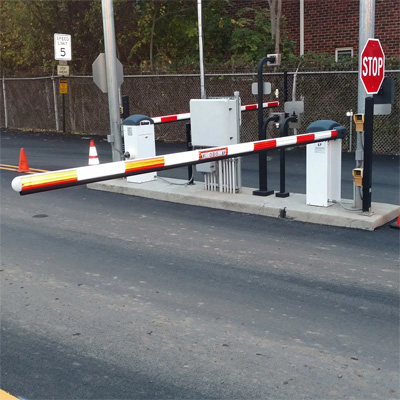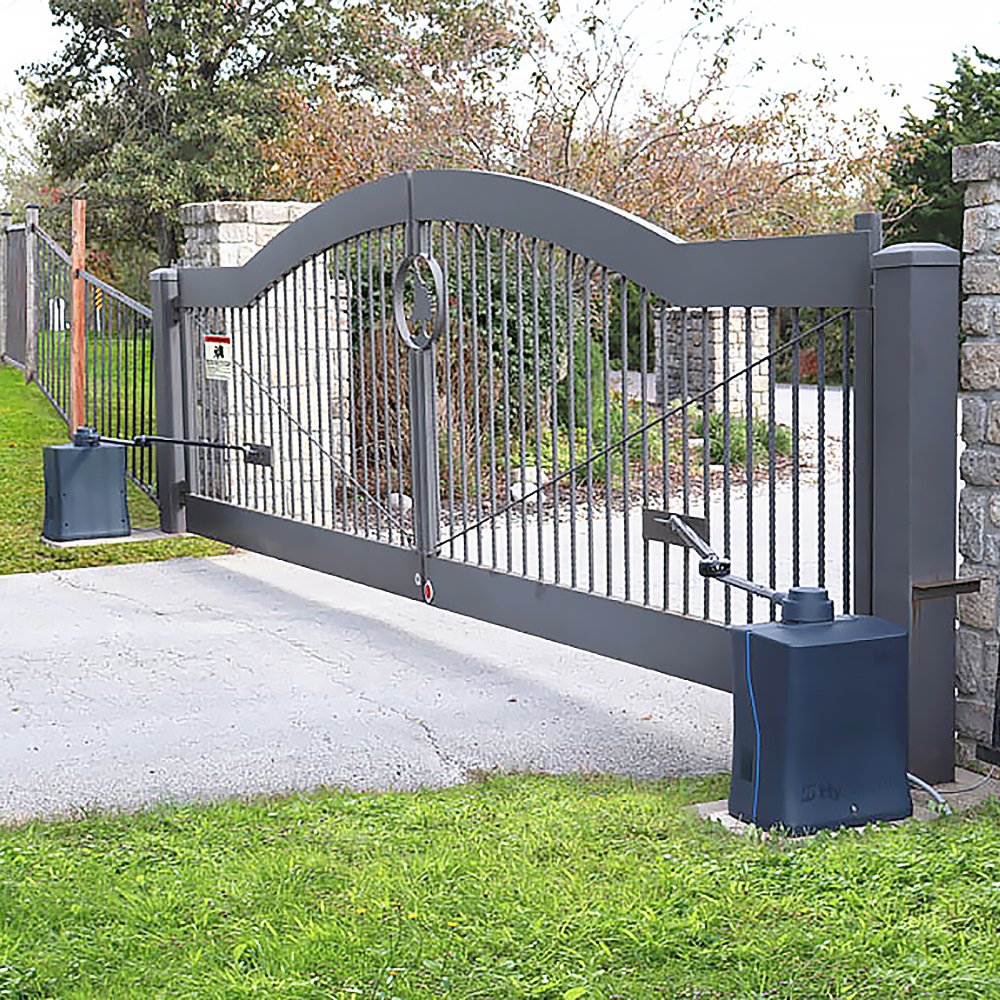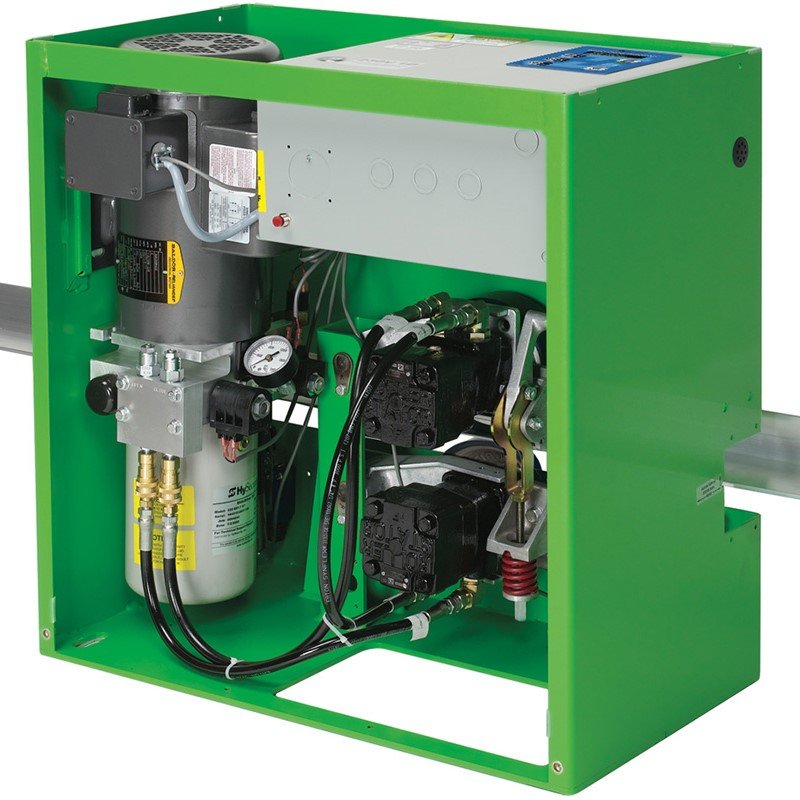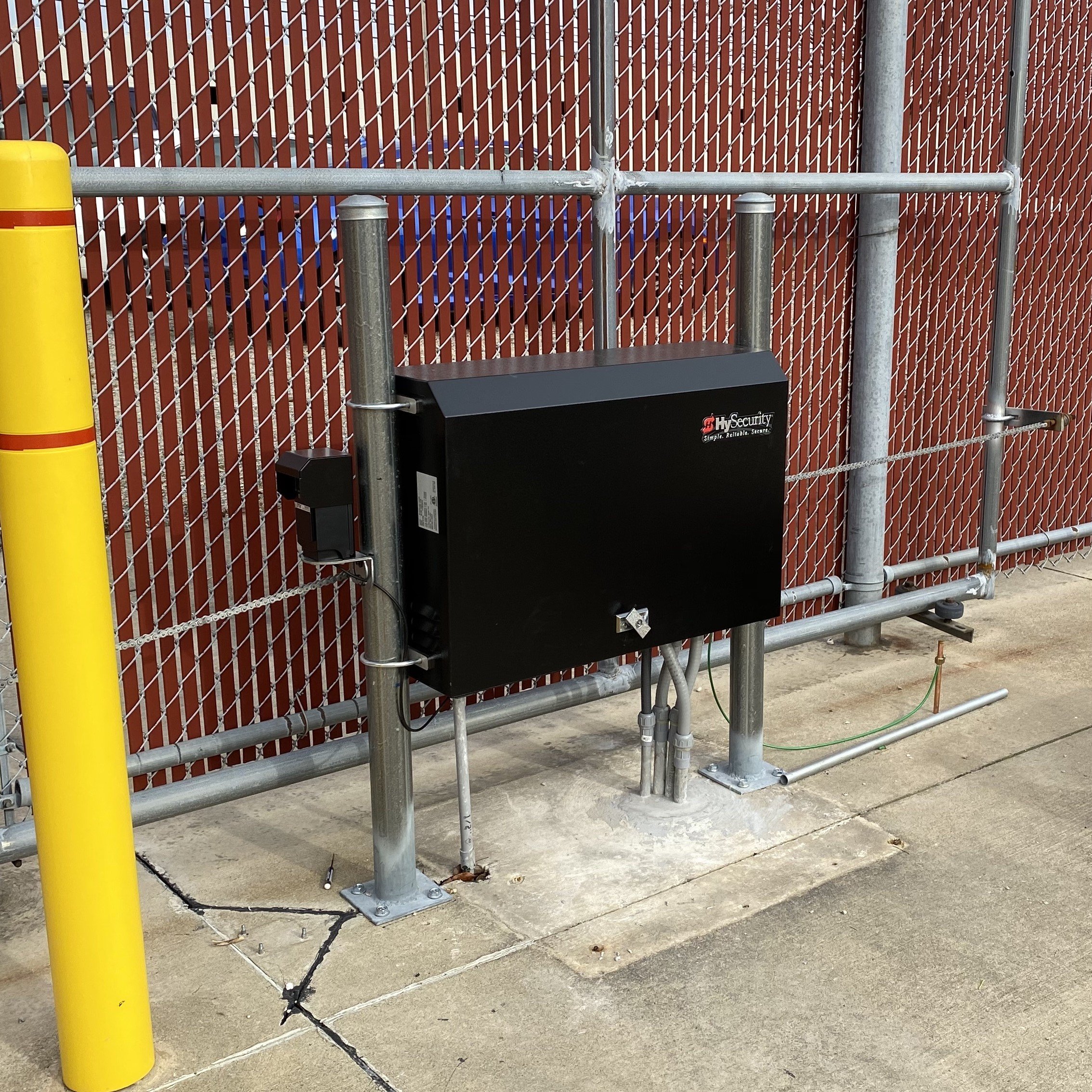Before you decide what type of gate you need, consider the following questions: What level of security is required for your site? What kinds of gates can easily fit where you need them installed? Do you wish for your gate to be visually appealing, or is it meant to dissuade intruders from attempting to pass through?
What Are The Different Kinds Of Automatic Gate Openers?
There are multiple automatic gate openers–five basic types, to be exact–each serving different purposes and functions. Listed below are every kind of automatic gate opener and what they are typically used for:
- Slide Gates: Slide gates move horizontally on a fixed track and are often found in commercial and industrial sites. They provide a high level of security and can be implemented in many different gate styles. Often in commercial locations, sliding gates work in tandem with traffic-controlling gate types such as barrier arms or HVM barriers. The dual use of both serves as an initial layer of security, with the traffic controller being the final layer one must pass through to enter.
- Swing Gates: Swing gates move horizontally as well, but in a wide arc along their face rather than from side to side like slide gates. One will commonly find these protecting residential sites and HOAs. They are easy to operate and have the potential to be displayed attractively. Still, they must be designed with up to 50% open space to allow proper airflow to lessen the effects of wind loading, as they are often susceptible to high winds.
- Hostile Vehicle Mitigation (HVM) Barriers: This traffic control barrier protects sites against hostile vehicle threats. There are different HVMs, including wedge barriers, active bollards, barrier arms, and crash-rated slide or swing gates. HVMs can cycle for every vehicle entering or exiting–or they can be programmed to only deploy under threatening conditions. The latter is otherwise known as final denial barriers.
- Barrier Arms: Barrier arms are typically used for traffic control and can be used with slide or swing gates. Other common uses are for anti-tailgating or to reduce vehicle strikes to the slide or swing gate it supports. They can be crash rated and provide final denial against hostile vehicular threats, much like HVMs.
Find the Right Gate Opener for You
What Level Of Barrier Gate Security Do I Need?
The level of security needed on your site also influences which type of automatic gate operator to use. Consider whether its operation should be a convenience open or if the location is meant to be a secured/hardened access point. Convenience opens are primarily utilized on residential sites, light commercial and industrial facilities, and generally anywhere else that may have frequent traffic coming from both sides of the barrier. If this accurately describes your site, you may want a slide or swing gate. However, if your site is used for more sensitive matters such as government facilities, airports, or prisons, then a hardened access point to enter or exit through would be more suitable. Utilizing HVMs or crash-tested barrier arms, these sensitive locations can be well and quickly protected against hostile vehicular threats.
Gate Openers by ApplicationWhy Does The Open/Close Speed Of Automatic Gate Openers Matter?
The speed at which your gate opens and closes is critical and a crucial element that affects the level of security the operator provides. As an example, when looking at a slide gate, the size of the opening, the intended means of passing through said opening, and how often it is meant to be opened and closed again all determine how long the gate will be open and how much extra space there may be for an unauthorized party to breach the barrier potentially.
Consider how fast access for approved parties should be and how often vehicles pass through. Different operators accommodate different speeds, so it is vital to determine what speed the model you choose is rated for. HySecurity slide gate openers operate at speeds as fast as 3ft./sec. The UL 325 also specifies the maximum speed limit of slide gates for UL Class I and II, so consider this.
What are UL 325 Safety Standards?
UL 325 Safety Standards are rules and regulations that must be followed to properly address the safety concerns and requirements needed for the automatic operation of all garage doors, vehicular gates, draperies, exterior awnings, louvers, windows and other opening and closing appliances rated 600 V or less. This standard was created by industry leaders working alongside Underwriters Laboratories (UL) with a primary goal of evaluating products in the interest of public safety, including the prevention of fire and electrical hazards. Check out our full guide for more information!
- Class I - Residential Vehicular Gate Operator: "A vehicular gate operator or system intended for use in garages or parking areas associated with a residence of one to four single families."
- Class II - Commercial/General Access Vehicular Gate Operator: A vehicular gate operator or system intended for use in a commercial location or building such as a multi-family housing unit (five or more single-family units), hotels, garages, retail store, or other buildings accessible by or servicing the general public."
- Class III - Industrial /Limited Access Vehicular Gate Operator: "A vehicular gate operator or system intended for use in an industrial location or building such as a factory or loading dock area or other locations not accessible by or intended to service the general public."
- Class IV - Restricted Access Vehicular Gate Operator: "A vehicular gate operator or system intended for use in a guarded industrial location or building such as an airport security area or other restricted access locations not servicing the general public, in which authorized access is prevented via supervision by security personnel."
Are HySecurity Gate Operators UL 325 Compliant?
Yes, all currently manufactured HySecurity gate operators comply with UL 325 standards when installed with approved monitored entrapment protection devices. This includes photo eyes, edge sensors, and other safety mechanisms required to prevent injury or damage. Compliance with UL 325 is mandatory for automated gate systems in the United States and ensures that the system operates safely under all conditions. HySecurity provides specific instructions and compatible devices to maintain certification during installation.
UL325 Safety Standards GuideHow Do Gate Panel Sizes and Weights Effect Performance of a Gate Opener?
Another factor that can help narrow your search for the perfect operator can be identifying the size and weight of the gate panel needed. For example, HySecurity SlideDriver models have weight capacities ranging from 1,500 to 20,000 lbs. If you are considering a swing gate, wind load should also be considered, as it will affect its overall weight and performance. As previously mentioned, an easy way to lessen wind load would be to consider a gate panel that provides at least 50% of open space. The HySecurity swing gate model, HydraSwing, offers a unique solution to swing gates with a lot of wind loading.
What Happens To Automatic Gate Openers During Power Outages?
Power outages can and will affect the operation of your gate if you are not thoroughly prepared for the possibility. Consider models that offer UPS battery backup, which allows continuous operation for 24 to 48 hours during a blackout. This is typical for most installations and can remain effective until standard AC power is restored. HySecurity offers various gate operators UPS battery backups in DC and AC inverter options.
What Kind of Backup Power Options Are Available for HySecurity Gate Openers?
HySecurity offers robust backup power solutions for both DC and hydraulic models to ensure gate functionality during power outages. DC-powered operators like the SlideSmart DC come with onboard batteries that provide multiple open/close cycles when utility power is lost. Hydraulic operators can be equipped with UPS (uninterruptible power supply) or external battery backup systems as well. These options are essential for critical access points where uptime and emergency access are non-negotiable.
Can HySecurity Operators Run on Solar Power?
Yes, several HySecurity models, such as SlideSmart DC and SwingSmart DC, are available in solar-compatible versions. These models are designed with low-power circuitry and high-efficiency components to support solar energy applications. They include features like energy-saving modes, battery backups, and smart charging systems to optimize performance in off-grid locations. Solar options are ideal for remote installations where utility power is unreliable or unavailable, such as ranches, private roads, and perimeter gates far from buildings.
How Do I Order a HySecurity Gate Opener System?
Please contact us directly to initiate your order for a HySecurity gate opener system. Our product specialists will gather details about your site, usage frequency, gate size, and access control needs to recommend the right model. Pricing varies depending on your selected configuration, and volume-based discounts may apply for multi-unit or large-scale installations. We ensure a streamlined process from selection to delivery, tailored to meet your project’s technical and security requirements.
Contact Us How to Order a HySecurity Gate OpenerWhat’s the Difference Between Slidedriver and Slidesmart Models?
SlideDriver models are hydraulic operators engineered for intensive-duty cycles and extreme environments such as correctional facilities, government perimeters, and data centers. In contrast, SlideSmart models are electromechanical and better suited for commercial, residential, and light industrial applications where continuous operation is not required. The hydraulic systems in SlideDrivers offer superior torque and longevity under constant use, whereas SlideSmart units offer quiet operation and energy efficiency. Your choice should depend on the operational demands, site constraints, and desired maintenance frequency.
Which HySecurity Gate Opener Is Best for High-Security or Crash-Rated Applications?
For sites that require anti-ram protection, HySecurity offers several crash-rated solutions including the StrongArm M30 and M50 barriers, ARC retractable bollards, and the ARC HydraWedge active vehicle barriers. These systems meet ASTM crash certification standards and are deployed at military bases, embassies, and other critical infrastructure facilities. They are designed to stop or deter hostile vehicle threats and integrate seamlessly with security command systems. Selection depends on threat level, response time requirements, and available installation space.
Can HySecurity Gate Openers Integrate With Access Control Systems?
Absolutely, HySecurity gate operators are engineered with integration in mind and support a wide range of access control technologies. These include keypad entry systems, RFID card readers, vehicle loop detectors, telephone entry systems, and enterprise-grade access control platforms. The built-in Smart Touch Controller offers flexible I/O and programmable logic for seamless communication with third-party devices. This makes it easy to incorporate HySecurity products into residential communities, commercial properties, and government installations.
Shop All AccessoriesDo I Need a Professional Installer to Install a HySecurity Gate Opener or Can I Install It Myself?
We strongly recommend professional installation by certified dealers or trained technicians. These systems involve electrical wiring, network configuration, safety integration, and code compliance that go beyond basic DIY skills. Improper installation can void warranties, compromise safety, and result in costly rework or malfunctions. Certified installers ensure the system is configured to site-specific needs and meets local regulations and UL 325 safety requirements.
How Often Does a HySecurity Operator Require Maintenance?
Maintenance schedules for HySecurity gate operators vary by model and usage frequency, but most systems are engineered for low-maintenance performance. SlideDriver hydraulic models, for example, are built to withstand millions of cycles with periodic oil checks and hose inspections. Electromechanical units like SlideSmart DC require routine lubrication, battery checks, and visual inspection of belts and gears. Following the manufacturer’s recommended maintenance schedule ensures optimal performance and prolongs the life of your gate system.
Shop All Parts Find the Right Partsfor Your HySecurity Opener
Contact Us
Still have questions about HySecurity gate operators, installation requirements, or technical specifications? If you're planning a new project or upgrading an existing system, our team is here to help guide you through every step. We also provide access to manuals, wiring diagrams, and expert technical support to ensure your system performs reliably. Reach out to us today to speak with a specialist or request a customized quote for your site!
Contact Us
